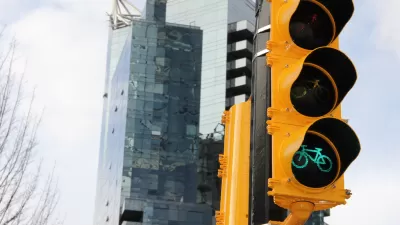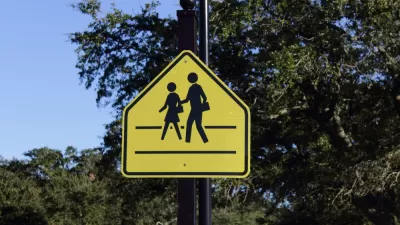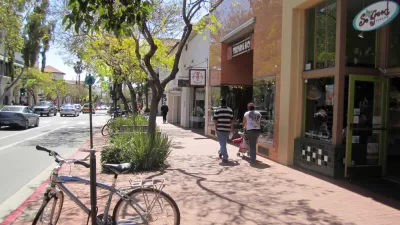Bike boxes and bike traffic signals can greatly assist cyclists in navigating through intersections where the majority of bike-motor vehicle collisions occur. A key advisory committee may recommend official acceptance, which would green-light them.

These two innovative bike infrastructure devices used by some bike-friendly U.S. cities and more widely used in Europe "are not fully recognized by one of the country’s most important engineering guides," writes Angie Schmitt. "But there are new signs that these two treatments are on their way to official acceptance from the engineering establishment."
Image: Otrec
"Bike boxes and bike signals are currently classified as 'experimental' in the Manual on Uniform Traffic Control Devices — which stops many local agencies from installing them. But there are new signs that these two treatments are on their way to official acceptance from the engineering establishment," writes Schmitt.
According to its website, "(t)he Manual on Uniform Traffic Control Devices, or MUTCD defines the standards used by road managers nationwide to install and maintain traffic control devices on all public streets, highways, bikeways, and private roads open to public traffic. The MUTCD is published by the Federal Highway Administration..."
The value of bike boxes and traffic lights is demonstrated at intersections. "Analyses of motor vehicle and police-reported crash data reveal that nearly 68 percent of bicycle crashes in Portland, Oregon occur at intersections (PDOT, 2004) which is consistent with national trends (Hunter et al., 1996)", according to OTREC, "a partnership between Portland State University, the University of Oregon, Oregon State University and the Oregon Institute of Technology."
According to Streetswiki, "the bike box is a 14-foot wide rectangle marked in front of the stop line for motorists, but behind the pedestrian crosswalk. (It) provides room for several bicyclists (and is) used in conjunction with bike lanes, from which bicyclists pedal directly into the box. The boxes have no intended function when traffic is already in motion."
Bike boxes work best at intersections with a high volume of bicyclists. They improve cyclists' visibility. They reduce delay for cyclists by providing space for "jumping the queue" of waiting vehicles. They allow a left-turning bicyclist to reach a better position for making a safe turn. They allow bicyclists to reduce exposure to vehicle tailpipe emissions, and are also thought to elevate the "status" of bicyclists relative to motor vehicles.
The "National Association of City Transportation Officials (NACTO) has provided detailed information and guidance for appropriate locations to install bicycle signal heads," as we noted in January.
Schmitt writes that an advisory group may recommend updates to the MUTCD to sanction use of bike boxes and traffic signals, currently considered experimental, at its January meeting.
MUTCD approval “gives cities interested in these tools permission to use them,” said Darren Flusche, policy director at the League of American Bicyclists. “It will help traffic engineers in those cities sleep easier at night knowing that the treatment is officially approved.”
NACTO provides additional intersection treatments for transportation planners and engineers to consider.
FULL STORY: Engineering Establishment Poised to Endorse Bike Boxes and Bike Signals

Alabama: Trump Terminates Settlements for Black Communities Harmed By Raw Sewage
Trump deemed the landmark civil rights agreement “illegal DEI and environmental justice policy.”

Study: Maui’s Plan to Convert Vacation Rentals to Long-Term Housing Could Cause Nearly $1 Billion Economic Loss
The plan would reduce visitor accommodation by 25% resulting in 1,900 jobs lost.

Planetizen Federal Action Tracker
A weekly monitor of how Trump’s orders and actions are impacting planners and planning in America.

Waymo Gets Permission to Map SF’s Market Street
If allowed to operate on the traffic-restricted street, Waymo’s autonomous taxis would have a leg up over ride-hailing competitors — and counter the city’s efforts to grow bike and pedestrian on the thoroughfare.

Parklet Symposium Highlights the Success of Shared Spaces
Parklets got a boost during the Covid-19 pandemic, when the concept was translated to outdoor dining programs that offered restaurants a lifeline during the shutdown.

Federal Homelessness Agency Places Entire Staff on Leave
The U.S. Interagency Council on Homelessness is the only federal agency dedicated to preventing and ending homelessness.
Urban Design for Planners 1: Software Tools
This six-course series explores essential urban design concepts using open source software and equips planners with the tools they need to participate fully in the urban design process.
Planning for Universal Design
Learn the tools for implementing Universal Design in planning regulations.
Caltrans
Smith Gee Studio
Institute for Housing and Urban Development Studies (IHS)
City of Grandview
Harvard GSD Executive Education
Toledo-Lucas County Plan Commissions
Salt Lake City
NYU Wagner Graduate School of Public Service





























